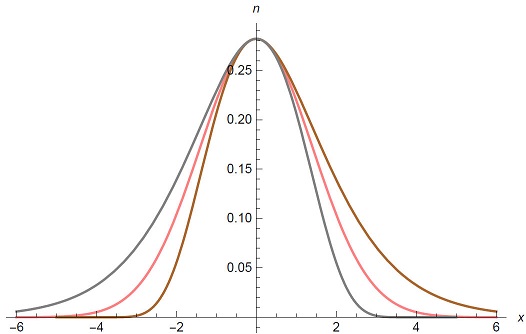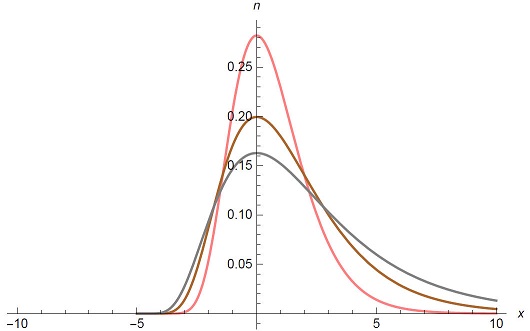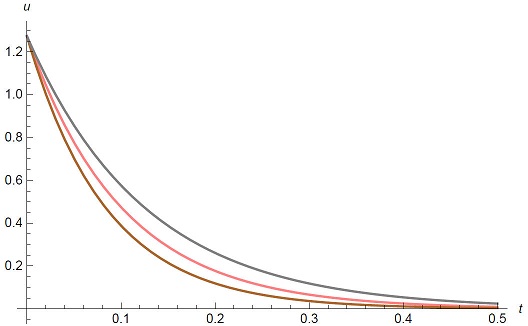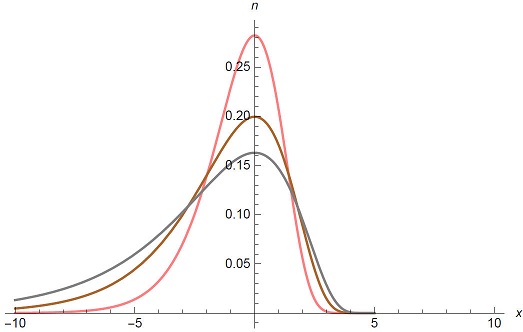1 Introduction
Heat equation governs how heat diffuses or transfers through a region, which was first introduced by Fourier [1] in 1822. In one dimension, this equation take the form,
where u(x, t) is the temperature at position x at time t and
In this paper we are to find a deformed heat equation. To do so we need the discrete version of heat equation where space is discrete but time is continuous. Discrete physics have been studied in various fields [2-15]. If we consider discrete positions denoted by
we have the discrete heat equation,
where finite difference operators are defined as
If we take the limit
which implies that the uniform space interval guarantees the heat equation of the form (1). In other words, if we consider a non-uniform discrete position, we will obtain another form of heat equation.
In this paper we consider the discrete heat equation with a certain non-uniform space interval which is related to q-addition or q-subtraction appearing in the non-extensive entropy theory [16-18]. By taking the continuous limit, we obtain the q-deformed heat equation. Similarly, we derive the q-deformed diffusion equation. This paper is organized as follows: In Sec. 2 we discuss the q-deformed heat equation. In Sec. 3 we discuss the solution of q-deformed heat equation. In Sec. 4 we discuss cooling of a rod from a constant initial temperature. In Sec. 5 we discuss the q-deformed diffusion equation.
2 q-deformed heat equation
In this section we discuss the q-deformed heat equation based on the the q-addition and q-subtraction appearing in the non-extensive thermodynamics [16-18]. As is different from the non-extensive thermodynamics, we introduce the parameter q so that it may have a dimension of inverse length. In the non-extensive thermodynamics, the parameter q is dimensionless. Thus, in the q-deformed heat equation, q can be regarded as 1/ξ where ξ denotes a length scale.
Now let us introduce the discrete position with non-uniform interval where the distance between adjacent positions are given by
or
where the q-addition and q-subtraction [16-18] are defined as
As is different from the uniform lattice, the non-uniform lattice consisting discrete points obeying Eq. (6) can be regarded as an example of the non-homogeneous medium in the continuous limit (
The Eq. (6) gives the relation
Solving Eq. (10) we get
When q > 0 we have > 0 we have
and
When q > 0 we have < 0 we get
and
In this case we demand
For the discrete positions obeying Eq. (6), the difference operator becomes
Thus, in the continuum limit, we get
Here we know that the q-derivative
3 Solution of q-deformed heat equation
Consider a rod of length L with the initial condition
and the boundary condition
We look for a solution of the form
Inserting Eq. (22) into Eq. (19) we get
Thus, we have
and
From the boundary function, we have A = 0 and
which gives
Thus, the general solution of q-deformed wave equation is
Now let us apply the initial condition. Then we have
If we use the orthogonality relation
we have
Here we solved the q-heat equation in a closed form. Our method is to introduce the q-lattice as an example of the non-homogeneous medium, which is not related to the numerical solution methods based on adaptive grids [21-24] because we obtained the exact solution.
4 Cooling of a rod from a constant initial temperature
Suppose the initial temperature distribution f(x) in the rod is constant, i.e. f(x) = u0. Now let us consider the case of L = 1, κ= 1. Then we have
Thus, we have
In this case, the ratio of the first and second terms in Eq. (33) is
where we used
and
Thus, the first term dominates the sum of the rest of the terms, and hence
4.1 Spatial temperature profiles
Now let us consider fixed time. Here we consider the time t = tq. Then we have
This has the maxima at x = x0 where
Thus, center of a rod is not a line of symmetry unless q = 0. Fig. 1 shows the plot of u versus x with u0 = 1 for q = 0 (Red), q = 0.2 (Brown), and q = -0.2 (Gray). We know that the position for maximum of u is smaller than 1/2 for q > 0 while it is larger than 1/2 for q < 0.
4.2 Temperature profiles in time
Setting x = x0 in the approximate solution, we have
Figure 2 shows the plot of u versus t with u0 = 1, x = x0 for q = 0 (Red), q = 0.2 (Brown), and q = -0.2 (Gray).
5 q-deformed diffusion equation
The q-deformed diffusion equation has the same form as the 𝑞-deformed heat equation,
where u(x, t) denotes the concentration and D denotes diffusivity. Now let us impose the initial condition
Now let us introduce the 𝑞-deformed Fourier transform as
and the inverse q-deformed Fourier transform
From the definition of q-deformed Fourier transform, we know
Taking the q-deformed Fourier transform in Eq. (43) we get
which is solved as
Then we have
Thus we get
Now let us set
which gives
Then we have
From the convolution theorem we get
If we impose the initial condition
we have
From Eq. (57), the expectation value of x are
For a small q, we get
The variance is then given by
For a small q, we get
Figure 3 shows the plot of u(x, t) versus x with t = 1 and D = 1 for q = 0 (Pink), q = 0.2 (Brown) and q = -0.2 (Gray). We know that the graph is asymmetric unless q = 0. Thus Eq. (57) is the asymmetric normal distribution. Figure 4 shows the plot of u(x, t) versus x with q = 0.2 and D = 1 for t = 1 (Pink), t = 2 (Brown) and t = 3 (Gray). Figure 5 shows the plot of u(x, t) versus x with q = 0.2 and D = 1 for t = 1 (Pink), t = 2 (Brown) and t = 3 (Gray).

Figure 3 Plot of u(x, t) versus x with t = 1 and D = 1 for q = 0 (Pink), q = 0.2 (Brown) and q = -0.2 (Gray).

Figure 4 Plot of u(x, t) versus x with q = 0.2 and D = 1 for t = 1 (Pink), t = 2 (Brown) and t = 3 (Gray).
6 Conclusion
In this paper we studied the q-deformed heat equation and q-deformed diffusion equation. From the fact that the ordinary heat equation was obtained by taking continuous limit in the discrete heat equation with a uniform space interval, we considered the discrete heat equation with a certain non-uniform space interval which was related to q-addition or q-subtraction appearing in the non-extensive thermodynamics. By taking the continuous limit, we obtained the q-deformed heat equation. We found that the q-deformed heat equation possessed the q-translation symmetry instead of the ordinary translation. We solved the q-deformed heat equation for a rod of length L. We discussed cooling of a rod from a constant initial temperature. We used the q-deformed Fourier transform to find the solution of the q-deformed diffusion equation. We found that the variance in x takes the form,
For a small q, we obtained
We found that the q-deformed diffusion process is asymmetric.
The q-addition and q-subtraction defined in the non-extensive thermodynamics was rarely used in the deformation of the space-time (q-deformed space time). The application to quantum mechanics was discussed in [20], application to mechanics was discussed in [25], and construction of q-lattice and q-Bloch theorem was discussed in [26].
Besides, we comment the connection of non-homogeneous media with the q-deformation of space briefly. It seems impossible to describe the general non-homogeneous media in an exact way without numerical study. Here, we adopted a special non-homogeneous media related to q-deformed space. Because asymmetry of the q-lattice, the graphs of temperature in the q-heat equation and concentration in the q-deformed equation became asymmetric, which had different feature for positive q and negative q, (See Fig. 1-5).
Finally, we compare the q-deformed diffusion equation with the diffusion model with the effective position dependent diffusion coefficient D(x) [27-29]. The diffusion equation with the effective position dependent diffusion coefficient D(x) was given in the form,
where w(x) denotes the variable cross section. Comparing Eq. (43) with Eq. (64), we know
Thus we know that the q-deformed diffusion equation is an example of the diffusion model with the effective position dependent diffusion coefficient.











 text new page (beta)
text new page (beta)





